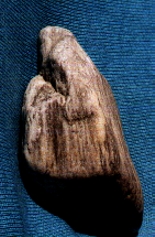A TRULY EXCEPTIONAL PIECE...

I found this beautiful little piece one winter's day while walking along an island beach in British Columbia, Canada.
Battered by waves for unguessed millenia before being washed up upon that shore, it had for me an unusual attraction as I first held it in my hand.
The shape was odd, and well outside what I would consider natural for a piece of stone. It felt to be of a slightly different density than normal for a piece of stone of its size. Its temperature was oddly neutral to the touch: neither as cold as a stone would be in the air's ambient chill, nor as warm as the sun should have made it.
The surface itself was unusual, too. It was smooth, yes, but...my fingertips clung to it ever so slightly, as if the waves had served to expose an almost imperceptible affinity to flesh from inside its form. It had a gentle roughness, a minutely smooth grittiness that allowed the touch to glide with ease over it yet, adhere firmly when such motion ended. It was as if this object had some long forgotten thirst for human contact.
Looking back now, I think that perhaps this piece was not stone at all. I think it more likely to have been ivory, perhaps even fossilized ivory.
Visually, this piece was like nothing else I had previously seen. It was a blend of subtle, pale grays and creamy whites. There were no definite, dark blacks apparent upon its surface; and the overall impression that it gave me was of distant, frozen mountain rock: encased in glaciers and snow, but constantly washed by incessant rains which, streaming down those ancient slopes, slowly exposed the ice-locked stone below until it was almost, but not quite, opened to sight.
In this gentle range of grays, my eyes rested upon a surface which seemed to yield softly before my gaze, as flesh softly eases beneath the slow warmth of a touch. This was a tactile sense of sight, a smooth and sensual release into visions from a far away past that I could reach out to and touch with my mind. There was a great restfulness of care palpably awaiting in this piece, a gentleness of intention tempered into an all the more so by some massive, unguessed hardness which had attended to its origin.
I won't go into detail about the images this piece presents: many of those are far away now, having been incessantly abraded by reality's relentless onward wash. Yet, these images still suggest themselves today, when this piece entwines itself with the shadows of low light situations; then, animals now long past manage to flesh themselves out again with darkness and outline. But there are a few things here I would like to draw forward into your attention and appreciation.
Of course, there is the image of a T. Rex: in profile facing left, with its mouth straining wide open and its eye intent upon its prey. That is the harsh terror which this piece presents: and there is also immeasurable beauty here. It wasn't until after I had photographed this piece, oriented to display the T. Rex, that I noticed what makes this piece such an exceptional thing of beauty.
The top, most heavily sculpted section of this piece presents an ancient family. They are dressed in the hooded clothes that protected them from the bitter cold of a glacial age. They face away from the T. Rex, perhaps fleeing from its immanent danger. The very top of this piece presents a man, who is looking straight ahead into the distance which they are traveling toward. Beside, slightly behind, and just a bit below him is a woman: her face still peers out from her parka's hood, tilted downward with love toward their child. This baby rests snuggly, in front of and between them, in a big, loose parka hood: warm and content, this child looks out into a world that has now moved thousands and thousands and thousands of years forward...to a world where people can still peek back in to admire how cute this little baby is; which is something that people still love to do, to this very day (and always will love to do, for as long as there are people and babies).
Well, of course you can see!
There is quite a bit more to see here, once you become accustomed to looking; but I'll leave you to explore and enjoy your own perceptions in the pleasure of this piece's differential texture.
...and, again, no one needs a Judge McEachern to tell them what they should be seeing here.